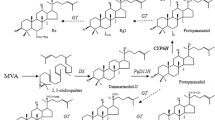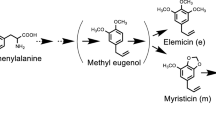Abstract
Panax quinquefolius is one of perennial herbs and well known for its outstanding pharmacological activity. Ginsenosides are thought to be the main active ingredients in Panax quinquefolius and exist in many kinds of plant genus Panax (ginseng). Dammarenediol synthase, which is considered as a key enzyme in ginsenoside biosynthesis pathway can convert 2, 3-oxidosqualene into dammarenediol-II. However, the dammarenediol synthase gene in Panax quinquefolius has not been identified. Here, we cloned and identified a dammarenediol synthase gene from Panax quinquefolius (PqDS, GenBank accession No. KC316048) at the first time, and reverse transcription-PCR (RT-PCR) analysis also showed an obvious transcription increase of PqDS in the methyl jasmonate (MeJA)-induced hairy roots. Ectopic expression of PqDS in yeast resulted in the production of dammarenediol-II was confirmed by liquid chromatography-atmospheric pressure chemical ionization mass spectrometry (LC/APCIMS). Moreover, overexpression of PqDS in transgenic hairy roots could increase the transcription of gene PqDS and another P450 gene PqD12H (encoding protopanaxadiol synthase in Panax quinquefolius), the accumulation of ginsenosides also increased at the same time. In addition, both PqDS and PqD12H gene co-expressed in recombinant yeast result in the production of protopanaxadiol was detected by LC/APCIMS; this result also provides a new strategy for the abundant production of protopanaxadiol in vitro.










Similar content being viewed by others
References
Akihisa T, Tokuda H, Ukiya M, Suzuki T, Enjo F, Koike K et al (2004) 3-Epicabraleahydroxylactone and other triterpenoids from Camellia oil and their inhibitory effects on Epstein–Barr virus activation. Chem Pharm Bull 52:153–156
Assinewe VA, Baum BR, Gagnon D, Arnason JT (2003) Phytochemistry of wild populations of Panax quinquefolius L. (North American ginseng). J Agric Food Chem 51:4549–4553
Attele AS, Wu JA, Yuan CS (1999) Ginseng pharmacology: multiple constituents and multiple actions. Biochem Pharmacol 58:1685–1693
Banno N, Akihisa T, Tokuda H, Yasukawa K, Higashihara H, Ukiya M et al (2004) Triterpene acids from the leaves of Perilla frutescens and their anti-inflammatory and antitumor-promoting effects. Biosci Biotechnol Biochem 68:85–90
Cai J, Yue XZ, Zhong JJ (2007) Protopanaxadiol 6-hydroxylase and its role in regulating the Ginsenoside heterogeneity in Panax notoginseng cells. Biotechnol Bioeng 100:933–939
Coleman CI, Hebert JH, Reddy P (2003) The effects of Panax ginseng on quality of life. J Clin Pharm Ther 28:5–15
Dey L, Xie JT, Wang A, Wu J, Maleckar SA, Yuan CS (2003) Anti-hyperglycemic effects of ginseng: comparison between root and berry. Phytomedicine 10:600–605
Gietz D, St Jean A, Woods RA, Schiestl RH (1992) Improved method for high efficiency transformation of intact yeast cells. Nucleic Acids Res 20:1425
Han JY, Kwon YS, Yang DC, Jung YR, Choi YE (2006) Expression and RNA interference-induced silencing of the dammarenediol synthase gene in Panax ginseng. Plant Cell Physiol 47:1653–1662
Han JY, Kim HJ, Kwon YS, Choi YE (2011) The Cyt P450 enzyme CYP716A47 catalyzes the formation of protopanaxadiol from dammarenediol-II during ginsenoside biosynthesis in Panax ginseng. Plant Cell Physiol 52:2062–2073
Hey SJ, Powers SJ, Beale MH, Hawkins ND, Ward JL, Halford NG (2006) Enhanced seed phytosterol accumulation through expression of a modified HMG-CoA reductase. Plant Biotechnol J 4:219–229
Kiefer D, Pantuso T (2003) Panax ginseng. Am Fam Physician 68:1539–1542
Kim OT, Bang KW, Kim YC, Hyun DY, Kim MY, Cha SW (2009) Upregulation of ginsenoside and gene expression related to triterpene biosynthesis in ginseng hairy root cultures elicited by methyl jasmonate. Plant Cell Tissue Organ Cult 98:25–33
Kima SJ, Murthy HN, Hahn EJ, Lee HL, Paek KY (2007) Parameters affecting the extraction of ginsenosides from the adventitious roots of ginseng (Panax ginseng C.A. Meyer). Sep Purif Technol 56:401–406
Kushiro T, Ohno Y, Shibuya Y, Ebizuka Y (1997) In vitro conversion of 2,3-oxidosqualene into dammarenediol by Panax ginseng microsomes. Biol Pharm Bull 20:292–294
Kushiro T, Shibuya M, Ebizuka Y (1998) b-Amyrin synthase: cloning of oxidosqualene cyclase that catalyzes the formation of the most popular triterpene among higher plants. Eur J Biochem 256:238–244
Landl KM, Klösch B, Turnowsky F (1996) ERG1, encoding squalene epoxidase, is located on the right arm of chromosome VII of Saccharomyces cerevisiae. Yeast 12:609–613
Lee MH, Jeong JH, Seo JW, Shin CG, Kim YS, In JG et al (2004) Enhanced triterpene and phytosterol biosynthesis in Panax ginseng overexpressing squalene synthase gene. Plant Cell Physiol 45:976–984
Liang Y, Zhao S (2008) Progress in understanding of ginsenoside biosynthesis. Plant Biol (Stuttg) 10:415–421
Poehland BL, Carte BK, Francis TA, Hyland LJ, Allaudeen HS (1987) In vitro antiviral activity of dammar resin triterpenoids. J Nat Prod 50:706–713
Samukawa K, Yamashita H, Matsuda H, Kubo M (1995) Simultaneous analysis of saponins in ginseng radix by high performance liquid chromatography. Chem Pharm Bull 43:137–141
Sasaki K, Minowa N, Kuzuhara H, Nishiyama S, Omoto S (1997) Synthesis and hepatoprotective effects of soyasapogenol B derivatives. Bioorg Med Chem Lett 7:85–88
Shibata S (2001) Chemistry and cancer preventing activities of ginseng saponins and some related triterpenoid compounds. J Korean Med Sci 16:S28–S37
Sun Y, Zhao SJ, Liang YL et al (2013) Regulation and differential expression of protopanaxadiol synthase in Asian and American ginseng ginsenoside biosynthesis by RNA interferences. Plant Growth Regul 71(3):207–217
Tansakul P, Shibuya M, Kushiro T, Ebizuka Y (2006) Dammarenediol-II synthase, the first dedicated enzyme for ginsenoside biosynthesis, in Panax ginseng. FEBS Lett 580:5143–5149
Usami Y, Liu YN, Lin AS, Shibano M, Akiyama T, Itokawa H et al (2008) Antitumor agents. 261. 20(S)-protopanaxadiol and 20(S)-protopanaxatriol as antiangiogenic agents and total assignment of (1)H NMR spectra. J Nat Prod 71:478–481
Vogler BK, Pittler MH, Ernst E (1999) The efficacy of ginseng. A systematic review of randomised clinical trials. Eur J Clin Pharmacol 55:567–575
Wang CZ, Wu JA, Mcentee E, Yuan CS (2006) Saponins composition in American ginseng leaf and berry assayed by high-performance liquid chromatography. J Agric Food Chem 54:2261–2266
Yu KW, Gao W, Hahn EJ, Paek KY (2002) Jasmonic acid improves ginsenoside accumulation in adventitious root culture of Panax ginseng C.A. Meyer. Biochem Eng J 11:211–215
Acknowledgments
This work was supported by the National High Technology Research and Development Program of China (863), NO. 2013AA102604, Projects of National Science Foundation of China, NO. 30970259. 31270337, Research Fund for the Doctoral Program of Higher Education of China, NO. 20120061110038, and Scientific and Technological Development Plan Project of Jilin Province, NO. 20130102041JC.
Author information
Authors and Affiliations
Corresponding author
Additional information
Hao-Jie Cao and Yao Sun assisted to this work.
Rights and permissions
About this article
Cite this article
Wang, L., Zhao, SJ., Cao, HJ. et al. The isolation and characterization of dammarenediol synthase gene from Panax quinquefolius and its heterologous co-expression with cytochrome P450 gene PqD12H in yeast. Funct Integr Genomics 14, 545–557 (2014). https://doi.org/10.1007/s10142-014-0384-1
Received:
Revised:
Accepted:
Published:
Issue Date:
DOI: https://doi.org/10.1007/s10142-014-0384-1




